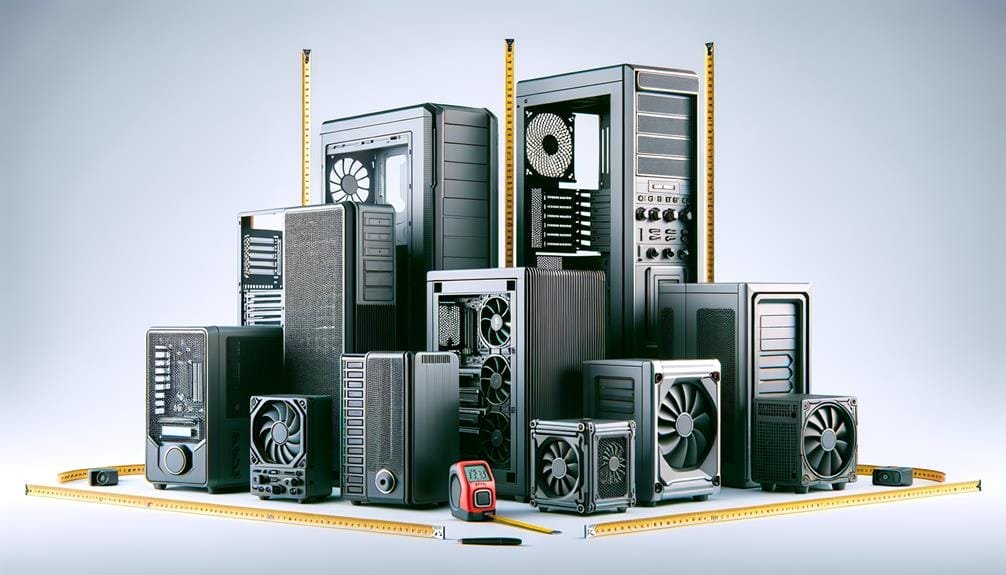Our Newsletter
Sign up for our e-mail newsletter and stay informed for what’s next on the horizon.
Often, we’re told, ‘Don’t judge a book by its cover,’ but in the case of choosing the appropriate computer case, that’s precisely what we’re doing. We’re not merely searching for a defensive layer, we’re evaluating factors such as design, cooling alternatives, visual appeal, and more.
This whole process is a complex puzzle that plays a significant role in the operation and durability of our cherished PCs. So, how does one traverse this complex labyrinth of choices and select the most suitable option? The solution is forthcoming, so let’s initiate the journey.
In the end, choosing the right computer case is similar to putting together a jigsaw puzzle. Each element, from the form factor to the cooling options and visual design, bears importance.
It’s crucial to carefully scrutinize each detail, aligning it with our individual needs and budget. Remember, there’s no one-size-fits-all answer. So, let’s take our time, carry out thorough research, and locate the computer case that seamlessly complements our technological creation.
Venturing into the fundamentals of computer cases, it’s vital to comprehend that they’re available in various sizes such as full tower, mid-tower, and mini-ITX, each engineered to house different motherboard sizes and components. By knowing these sizes, we can pick the correct case based on our build needs.
Full tower cases are the titans of the PC world. They’re constructed to accommodate extensive setups, including large motherboards like extended ATX, water-cooling systems, and multiple GPUs. They provide the most space for components, making them perfect for high-performance or server builds.
Mid-tower cases, alternatively, find a middle ground between size and functionality. They accommodate most ATX motherboards and still offer sufficient room for multiple components without being excessively large. These cases are adaptable, making them a preferred choice for many builders.
Finally, mini-ITX cases are the compact champions. They’re designed for small form factor builds, where space and portability are key. Despite their size, they can still house a mini-ITX motherboard and essential components. These cases embody the phrase, ‘good things come in small packages.’
Knowing case sizes is the initial step towards freedom in constructing your dream PC.
Grasping the significance of PC case size is a critical aspect of the PC assembly process, as it directly influences the compatibility of your components and the complete functionality of your setup. The dimensions of the case dictate the kind and quantity of components that can be housed inside.
Bigger cases, like full tower cases, offer abundant room for comprehensive water-cooling systems and large motherboards such as Extended-ATX.
Mid-tower cases, conversely, are favored because of their equilibrium between dimensions and compatibility. These cases can house ATX motherboards, and some even have room for E-ATX. They provide sufficient space for a reasonable quantity of components without taking up excessive room.
For those who prioritize portability, Mini-ITX cases are a good choice. They’re engineered for compact form factor builds, providing the advantage of mobility but with restricted space for hardware.
Alternatively, mini-tower cases, which can accommodate micro-ATX motherboards, are less widespread but offer a compromise between dimensions and compatibility.

When choosing a computer case, it’s vital to grasp the concept of form factors, their different types, and most importantly, the significance of compatibility.
Form factors determine the size and design of the case, which in turn affects its compatibility with various components. From the compact mini-ITX to the larger ATX towers, each form factor offers unique benefits and limitations.
This highlights the necessity to choose a case that aligns with our components and planned usage.
Choosing a computer case requires careful consideration of your proposed build’s form factor, as it influences the harmony between your motherboard and the case.
Taking into account the role of form factors in your PC assembly, we can now examine the different types and assist you in choosing the most suited one for your needs and preferences.
Among these form factors, mini-ITX cases are compact and optimal for those with space constraints, although they offer limited options for building and expansions.
For a touch more elasticity, micro-ATX cases may be a good choice, providing extra space for more components.
If you’re looking for adaptability, the customary ATX mid-sized tower is a popular choice. It’s compatible with most motherboards and provides ample options for building.
For those who prefer large, intricate builds, full ATX towers offer the maximum adaptability, accommodating extra components and expansions.
Choosing the right PC case requires thoughtful evaluation of compatibility, particularly in relation to the form factor you plan to implement. The arrangement of components inside the case, its shape, and the compatibility with the motherboard’s form factor, are all critical factors in this decision-making process.

Now we’ll discuss cooling and ventilation considerations, a vital aspect of picking the right computer case.
The pattern of airflow inside the case can heavily affect the efficacy of the cooling system.
To guarantee maximum operation, we’ll discuss how to select cases with correct fan layouts and comprehend their effect on the system’s total temperature control.
For the extended life of your computer, comprehending the flow of air inside the PC case is vital, as it plays a key role in cooling and averting overheating of components. By tactically positioning intake and exhaust fans, one can usher an ideal air flow and a positive air pressure setting.
To simplify this, let’s consider the following components:
Understanding the significance of airflow dynamics, it’s also vital to select the correct case fans for superior cooling and ventilation within your computer case. When determining the ideal PC case, we need to evaluate the cooling system it accommodates. Case sizes are a deciding factor here, as they dictate the quantity of case fans that can be mounted.
We’ve assembled the following table to assist you in making a knowledgeable decision:
| Consideration | Why It’s Important | Optimal Choice |
|---|---|---|
| Airflow & Heat Dissipation | Keeps components cool | Multiple fans or liquid cooling |
| Noise Level | Achieves a balance between performance and comfort | Fans with low dB ratings |
| Dust Filters | Ensures clean airflow | Cases with removable and washable filters |
Before choosing the appropriate computer case, it’s vital to correctly ascertain the quantity of drive bays our build will necessitate, taking into account our unique storage needs. The idea of drive bays may appear insignificant, but it’s key in defining storage needs, installation simplicity, and the possibility for hassle-free upgrades.
For a better understanding, we’ll examine the following aspects:

Turning our attention to the front-panel of the computer enclosure, we need to scrutinize its connectivity features, which generally comprise USB ports, audio jacks, and power buttons. The front-panel connectivity elements are vital as they offer convenient and swift access to different functions.
In our scrutiny, we’ll initially observe the kind and quantity of USB ports present. Enclosures with USB 3.0 and USB-C ports are desirable due to their rapid data transfer rates, which is crucial for contemporary connectivity. We’ll also search for audio jacks for headphones and microphones, and power buttons to activate and deactivate the system.
We won’t ignore the existence of a reset button, a practical tool for problem-solving. An LED indicator is another significant feature, giving a visual signal for power status. For hobbyists, additional features like fan controllers and RGB lighting controls are an extra advantage.
In addition to the operational components of a PC case, it’s essential to note the visual appeal and how it resonates with our individual tastes. The optimal PC case for you mightn’t only concern the dimensions, connectivity, or the amount of expansion slots, but also the design, color, and material that mirrors your personal fashion.
Here are a few factors to ponder that will aid in making the ultimate decision:
Acquiring the correct equilibrium between functionality and aesthetics can indeed result in a gratifying PC building journey.

Deciding on a PC case requires us to set a distinct budget, taking into account the equilibrium between expense and the features we desire. We need to acknowledge our financial constraints and the intent of the build. For those mindful of their budget, cases under $50 could be a viable option. However, these may only offer rudimentary features and restricted airflow.
A more balanced cost-to-performance ratio could be achieved with cases priced around the $100 point. This category typically provides improved features without causing a financial strain. It’s an optimal range that enables us to gain the most utility without sacrificing on vital elements like airflow and build materials.
For those pursuing high-grade performance, cases priced above $150 might be a choice to consider. These are accompanied by superior acoustics, connectivity choices, and are generally made of top-tier build materials. Although these may stretch our budget, the features and performance could warrant the expenditure.
Ultimately, the process of picking the right computer case is akin to assembling a puzzle. Each component, from the form factor to the cooling options and aesthetics, holds significance.
It’s necessary to meticulously evaluate every aspect, syncing it with our personal requirements and funds. Keep in mind, there isn’t a universal solution. Hence, let’s be patient, do our research, and find the computer case that perfectly fits our digital masterpiece.
The process includes evaluating the dimensions of your motherboard, the clearance for your CPU cooler and GPU, the number of drive bays needed, the amount of expansion slots, the ease of cable management, the airflow efficiency, possible cooling methods, and your personal aesthetic choices. It’s about finding the ideal equilibrium that suits your requirements.
Selecting a computer case is akin to choosing the ideal dwelling. Factors such as dimensions, compatibility, ventilation, and cable organization are crucial. The importance of a robust and appealing design cannot be overstated. The objective is to create a tech sanctuary tailored to our specifications.
In choosing a computer case, we take into account aspects like the design, compatibility, ventilation alternatives, storage space, and the durability of construction. These factors ensure that the case is suitable for our requirements, accommodates our hardware, and can handle our computational needs.
To ensure the computer case will accommodate all the parts, we’ll measure our components, check the form factor of the motherboard, and take into account the dimensions of the case. It’s also important to confirm there’s enough room for the CPU cooler, the graphics card, and to check the sizes of the drive bays and expansion slots. Good cable management is also crucial.
Sign up for our e-mail newsletter and stay informed for what’s next on the horizon.